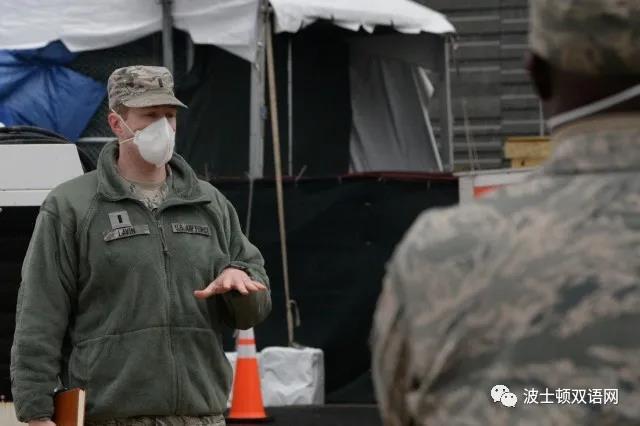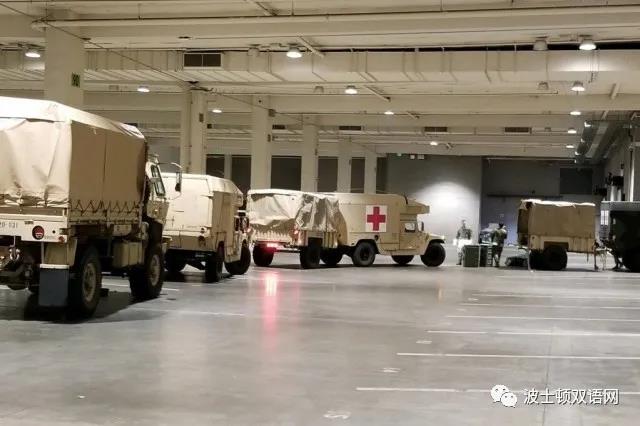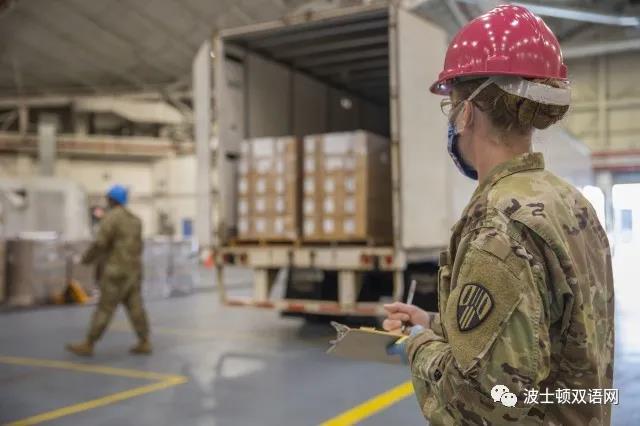【波士顿双语网2020年4月19日讯】在今天下午的白宫新冠肺炎疫情发布会中,特朗普对军方对抗疫工作作出的贡献给予了高度评价。特朗普表示,他赞成为地方政府提供更多的援助,但说明指将会待未来提交国会,而不是目前正在审议的援助方案。美国国会最近正审议总金额为4,000亿美元的新一轮经济支援方案,主要用作支援中小企业在疫情打击下重启运作,预料议案可于未来数日内通过。

特朗普表示会动用国防生产法,要求一间美国公司生产更多的棉花棒。特朗普称政府对这家公司感到「困难」,但没具体说明是什么。据媒体报道,这家公司总部位于缅因州的Puritan Medical Products,专门生产高质素棉花棒。美国为增加检测数需要大量采摘唾液样本的长条棉花棒,过去已有美媒报道指有医疗设施因棉花棒不足,影响检测运作。

由美国陆军工程兵部队牵头,疫情严重的纽约、波士顿、底特律等大城市的多个大型临时医院在过去两周改建完毕,已经开始收治新冠肺炎患者。美军各兵种在抗疫中承担了工程、供应链、医疗、甚至是尸体处理等艰巨任务。纽约国民警卫队的士兵和飞行员目前每天24小时值班,帮助纽约的各大医院体面地处理大量死亡患者的尸体,这对于他们的体力和情感的要求都非常高。
本月底将建成28个临时医院
美国陆军工程兵部队司令西蒙尼(Todd E. Semonite)中将近日对媒体宣布,在短短的十天之内,美国陆军工程兵部队在全国各地建造的临时医疗设施(alternate care facilities)从11个增加到28个,本月底将全部建成,交付地方政府使用。

西蒙尼中将说,新增加的临时医疗设施包括首都华盛顿的华盛顿会议中心(Walter E. Washington Convention Center)、密苏里州弗洛里森特(Florissant)市的一家酒店、迈阿密会议中心和丹佛市的科罗拉多会议中心(Colorado Convention Center in Denver)等。
西蒙尼说,“我十天前见你们的时候,数字还是17个”,“所以说过去十天中,临时设施的数字从17个增加到28个”。他说这28个临时医疗设施大约有病床1万5800张,既可以收治新冠病毒感染病患,也可用于其它疾病的治疗。

西蒙尼说,为了应对疫情的发展,陆军工程兵部队仅用四天时间就将密苏里州圣路易斯市一家酒店改造成一家拥有118张病床的临时医疗设施,并对通风系统进行了改装;工程兵部队在丹佛市利用18天时间将面积相当于六个橄榄球场的科罗拉多会议中心改建成拥有600张病床的临时医疗设施。

西蒙尼说,由于疫情发展迅速,依据现有设施进行改建,是建造临时医疗设施的最佳途径。陆军工程兵为此设计了新冠病毒感染病患的标准病床设施和其它疾病病患的标准病床设施,全美已经有41个州决定采用陆军工程兵的标准设计,改建临时医疗设施。
西蒙尼介绍说,陆军工程兵之前对纽约市贾维斯中心(Javits Center)、芝加哥麦考米克会议中心(McCormick Place)和底特律科博会议中心(TCF Center)等设施改建的10个临时医疗设施已全部竣工,开始收治第一批病患了。

NY National Guard executes somber duties in NYC
NEW YORK – The toughest COVID-19 mission facing the New York National Guard falls on 255 Soldiers and Airmen supporting New York City’s Office of the Chief Medical Examiner (OCME), according to Army Maj. Gen. Ray Shields, the adjutant general of New York.
The medical examiner’s office is responsible for the dignified recovery of people who die outside of a hospital. The staff was overwhelmed at the spike in COVID-19-related deaths in the city of 8.5 million people, so city officials turned to the New York National Guard for help.
Now, New York National Guard Soldiers and Airmen are on duty around the clock helping handle the physically and emotionally demanding responsibility of the dignified removal of remains.
“We arrived in New York City on Tuesday, touched down Wednesday morning for training with the OCME and Thursday we were out on the road,” described New York Air National Guard 1st Lt. Shawn Lavin, the commander of the 107th FSRT.
“The city hospitals are at or just about at their capacities,” Lavin said after his first week of missions. And the second and third-order effects of that is the “downstream impact,” Lavin said, referring to crowded hospital morgues and funeral homes.
“Teams go out each day,” Lavin said. “We’ll dispatch with the OCME in their vehicle and our team in the trail vehicle.”
The New York Air National Guard also provided Lavin’s team with 28 additional qualified personnel from across the wings to receive training and augment the recovery teams.
The teams operate across the city, supporting OCME missions in all five boroughs from central locations in Manhattan, Brooklyn and Queens. Fifteen teams operate each day and another group of 15 supports OCME each night.
“Soldiers understand the mission, how important it is and that their help is greatly needed by their fellow citizens and appreciated by authorities,” Command Sgt. Maj. David Piwowarski, the New York Army National Guard’s senior enlisted adviser, said following a visit to the teams April 12.
Dr. Oxiris Barbot, the New York City commissioner of health, told The New York Times April 14 that 3,000 more people died in the city between March 11 and April 13 than would normally have been expected during the same period in an ordinary year.